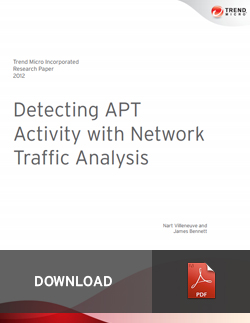Network Traffic Analysis Can Stop Targeted Attacks
February 21, 2013
 Download the full research paper: Detecting APT Activity with Network Traffic Analysis
Download the full research paper: Detecting APT Activity with Network Traffic Analysis
In fact, they do not always use zero-day exploits and often use older exploits and simple malware. Some, on the other hand, view the threats as pure hype conjured up by marketing departments even though they cannot explain why high-value targets worldwide suffer from repeated, successful, and long-term compromises.
While initial reports had a tendency to treat the cyber-espionage networks they uncovered as an “attack” or a “singular set of events,” it is becoming increasingly clear that most targeted attacks are in fact part of ongoing campaigns. They are consistent espionage campaigns—a series of failed and successful attempts to compromise a target over time—that aim to establish persistent, covert presence in a target network so that information can be extracted as needed.
Careful monitoring and investigation can help security researchers learn from the mistakes attackers make, allowing us to get a glimpse into malicious operations. In fact, we can track campaigns over time by relying on a combination of technical and contextual indicators. This paper focuses on using this threat intelligence to detect APT activity with network traffic analysis.
HIDE
Like it? Add this infographic to your site:
1. Click on the box below. 2. Press Ctrl+A to select all. 3. Press Ctrl+C to copy. 4. Paste the code into your page (Ctrl+V).
Image will appear the same size as you see above.
Recent Posts
- You Can't See Me: Achieving Stealthy Persistence in Azure Machine Learning
- Mitigating the Threat of Sidecar Container Injection
- Open RAN: Attack of the xApps
- Rise in Active RaaS Groups Parallel Growing Victim Counts: Ransomware in 2H 2023
- Apache APISIX In-the-wild Exploitations: An API Gateway Security Study
 MQTT and M2M: Do You Know Who Owns Your Machine’s Data?
MQTT and M2M: Do You Know Who Owns Your Machine’s Data? Building Resilience: 2024 Security Predictions for the Cloud
Building Resilience: 2024 Security Predictions for the Cloud Rise in Active RaaS Groups Parallel Growing Victim Counts: Ransomware in 2H 2023
Rise in Active RaaS Groups Parallel Growing Victim Counts: Ransomware in 2H 2023 Mitigating the Threat of Sidecar Container Injection
Mitigating the Threat of Sidecar Container Injection